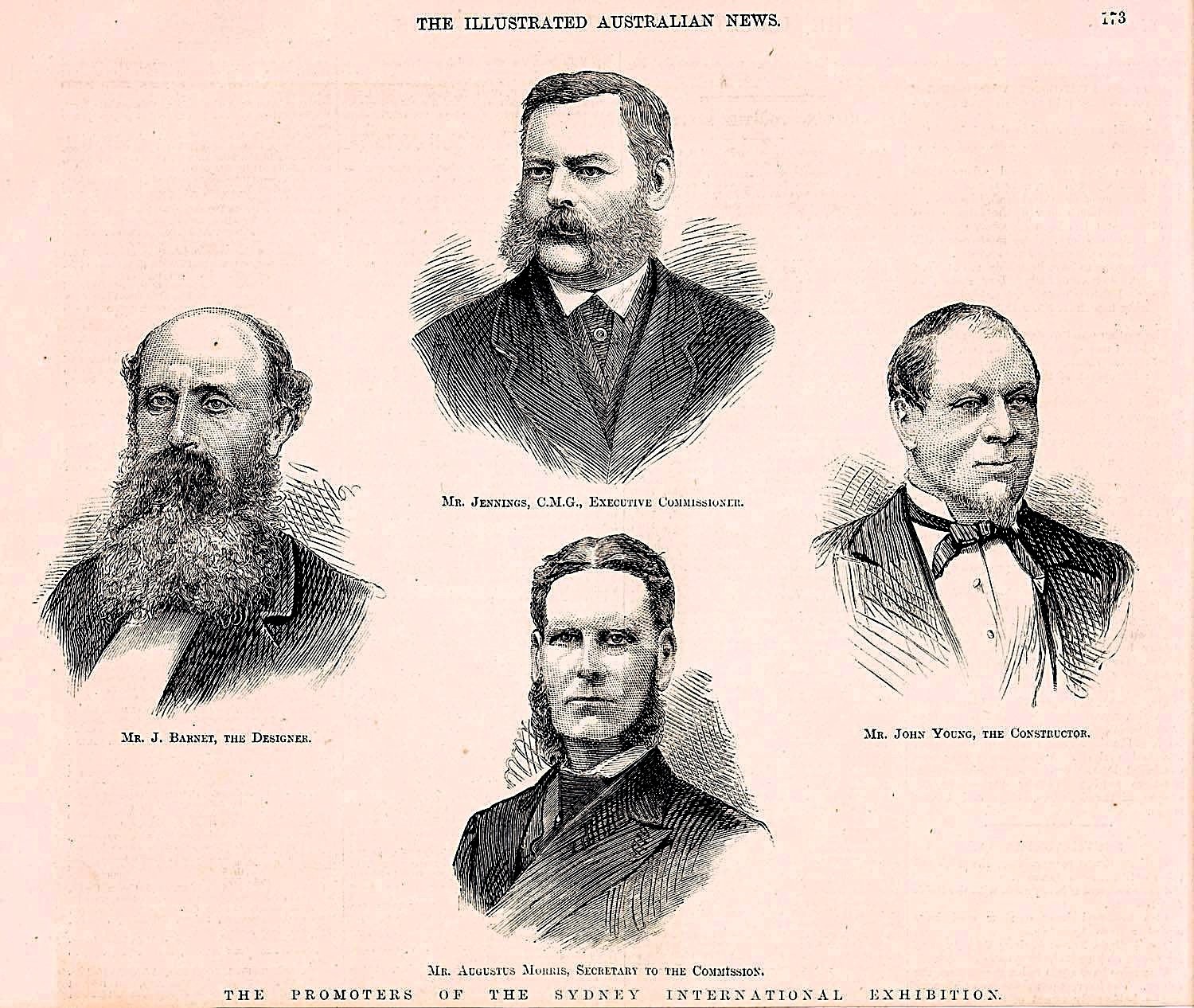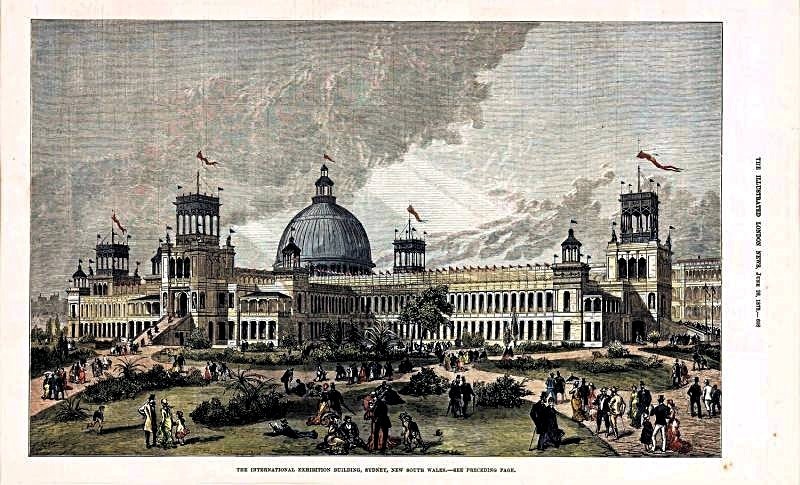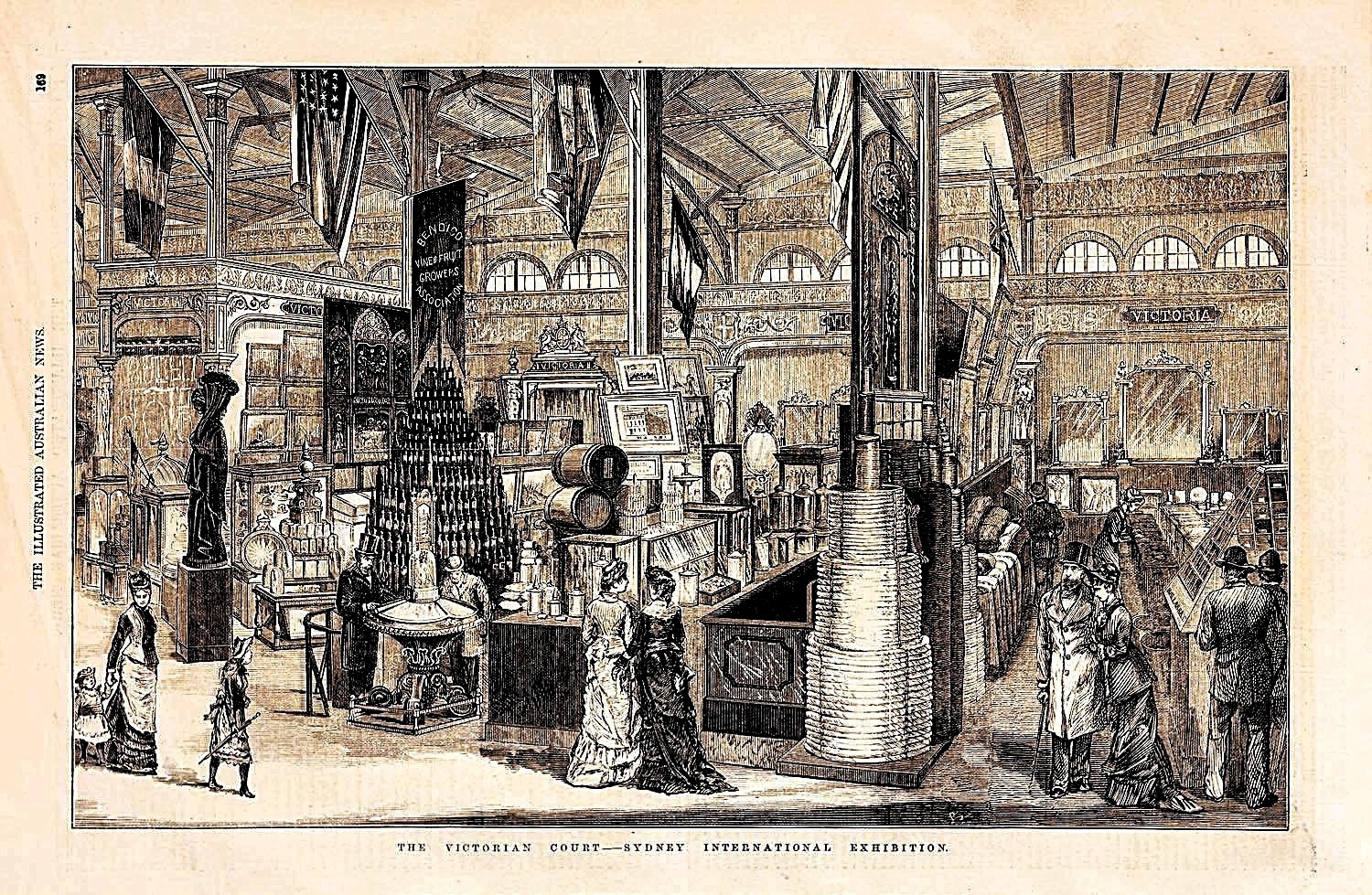Sydney International Exhibition on:
[Wikipedia]
[Google]
[Amazon]
The Sydney International Exhibition was established headed by
 In late 1877, the Agricultural Society of New South Wales discussed the possibility of hosting an international exhibition in Sydney. Jules Joubert proposed importing the goods from the Universal Exposition in Paris in 1878 as a basis of the exhibition. On 31 December 1878, the Royal Commission for the Sydney International Exhibition was established headed by Lord Augustus Loftus.
In late 1877, the Agricultural Society of New South Wales discussed the possibility of hosting an international exhibition in Sydney. Jules Joubert proposed importing the goods from the Universal Exposition in Paris in 1878 as a basis of the exhibition. On 31 December 1878, the Royal Commission for the Sydney International Exhibition was established headed by Lord Augustus Loftus.
 A site of on the high ground of the Inner Domain along Macquarie Street was chosen for the exhibition. James Johnstone Barnet designed a massive building called the
A site of on the high ground of the Inner Domain along Macquarie Street was chosen for the exhibition. James Johnstone Barnet designed a massive building called the

 There were 23 nations represented at the Exhibition. Africa:
There were 23 nations represented at the Exhibition. Africa:
Lord Augustus Loftus
Lord Augustus William Frederick Spencer Loftus, (4 October 1817 – 7 March 1904) was a British diplomat and colonial administrator. He was Ambassador to Prussia from 1865 to 1868, to the North German Confederation from 1868 to 1871 and to the ...
and took place in Sydney
Sydney ( ) is the capital city of the state of New South Wales, and the most populous city in both Australia and Oceania. Located on Australia's east coast, the metropolis surrounds Sydney Harbour and extends about towards the Blue Mountain ...
in 1879, after being preceded by a number of Metropolitan Intercolonial Exhibition
The first Sydney Intercolonial Exhibition was a series of exhibitions inspired by the historic Great Exhibition held in London in 1851. The Colony of New South Wales mounted its first such exhibition in 1854 in preparation for the Paris Exhibit ...
s through the 1870s in Prince Alfred Park
Surry Hills is an inner-city suburb of Sydney, in the state of New South Wales, Australia. Surry Hills is immediately south-east of the Sydney central business district in the local government area of the City of Sydney. Surry Hills is sur ...
.
Organisation
 In late 1877, the Agricultural Society of New South Wales discussed the possibility of hosting an international exhibition in Sydney. Jules Joubert proposed importing the goods from the Universal Exposition in Paris in 1878 as a basis of the exhibition. On 31 December 1878, the Royal Commission for the Sydney International Exhibition was established headed by Lord Augustus Loftus.
In late 1877, the Agricultural Society of New South Wales discussed the possibility of hosting an international exhibition in Sydney. Jules Joubert proposed importing the goods from the Universal Exposition in Paris in 1878 as a basis of the exhibition. On 31 December 1878, the Royal Commission for the Sydney International Exhibition was established headed by Lord Augustus Loftus.
Architecture
 A site of on the high ground of the Inner Domain along Macquarie Street was chosen for the exhibition. James Johnstone Barnet designed a massive building called the
A site of on the high ground of the Inner Domain along Macquarie Street was chosen for the exhibition. James Johnstone Barnet designed a massive building called the Garden Palace
The Garden Palace was a large, purpose-built exhibition building constructed to house the Sydney International Exhibition in 1879 in Sydney, Australia. It was designed by James Barnet and constructed by John Young, at a cost of £191,800 in on ...
. The nave of the building measured 800 x 60 feet and the transept ran for 500 feet. A large dome 100 feet in diameter rose 90 feet above the building. The builder, John Young John Young may refer to:
Academics
* John Young (professor of Greek) (died 1820), Scottish professor of Greek at the University of Glasgow
* John C. Young (college president) (1803–1857), American educator, pastor, and president of Centre Col ...
, finished the building in just eight months at a cost of £191,800. International response grew so rapidly that in June 1879, construction began on two large machinery halls and an art gallery.
Transport
Four steam tram motors were imported to Sydney and tracks laid from the Redfern railway station to the site. Intended as a temporary transport installation, this became the genesis of a largertram network
A tram (called a streetcar or trolley in North America) is a rail vehicle that travels on tramway tracks on public urban streets; some include segments on segregated right-of-way. The tramlines or networks operated as public transport are ...
and probably the exhibition's most lasting legacy..
International participation

 There were 23 nations represented at the Exhibition. Africa:
There were 23 nations represented at the Exhibition. Africa: Cape Colony
The Cape Colony ( nl, Kaapkolonie), also known as the Cape of Good Hope, was a British Empire, British colony in present-day South Africa named after the Cape of Good Hope, which existed from 1795 to 1802, and again from 1806 to 1910, when i ...
; America: Canada, United States; Asia: Ceylon
Sri Lanka (, ; si, ශ්රී ලංකා, Śrī Laṅkā, translit-std=ISO (); ta, இலங்கை, Ilaṅkai, translit-std=ISO ()), formerly known as Ceylon and officially the Democratic Socialist Republic of Sri Lanka, is an ...
, India, Japan, British Malaya
The term "British Malaya" (; ms, Tanah Melayu British) loosely describes a set of states on the Malay Peninsula and the island of Singapore that were brought under British hegemony or control between the late 18th and the mid-20th century. U ...
, Singapore, Straits Settlement
The Straits Settlements were a group of British territories located in Southeast Asia. Headquartered in Singapore for more than a century, it was originally established in 1826 as part of the territories controlled by the British East India Comp ...
; Europe: Austria, Belgium, Denmark, France, Germany, Great Britain, Ireland, Italy, Netherlands, Switzerland; Oceania: Fiji, New Caledonia, New Zealand, and from the Australian continent, the colony of New South Wales
The Colony of New South Wales was a colony of the British Empire from 1788 to 1901, when it became a State of the Commonwealth of Australia. At its greatest extent, the colony of New South Wales included the present-day Australian states of New ...
, Colony of Queensland
The Colony of Queensland was a colony of the British Empire from 1859 to 1901, when it became a State in the federal Commonwealth of Australia on 1 January 1901. At its greatest extent, the colony included the present-day State of Queensland, t ...
, Colony of South Australia
In modern parlance, a colony is a territory subject to a form of foreign rule. Though dominated by the foreign colonizers, colonies remain separate from the administration of the original country of the colonizers, the '' metropolitan state'' ...
, Colony of Tasmania
The Colony of Tasmania (more commonly referred to simply as "Tasmania") was a British colony that existed on the island of Tasmania from 1856 until 1901, when it federated together with the five other Australian colonies to form the Commonwealt ...
, and the Colony of Victoria
In modern parlance, a colony is a territory subject to a form of foreign rule. Though dominated by the foreign colonizers, colonies remain separate from the administration of the original country of the colonizers, the '' metropolitan state'' ...
. There were 9,345 exhibitors providing about 14,000 exhibits.
After being granted self-governance during the 1850s, the Australian colonies, Victoria and New South Wales, saw a steady economic growth as result of the discovery and exploitation of gold reserves. After 20 years proposals were made for organising an exhibition modelled on the great exhibitions of Europe, with an aim to promote commerce and industry, along with art, science and education. In 1879 Melbourne filed a plan to the Parliament. However, Sydney wanted to be the first and managed to organise an exhibition in record time.
The Sydney International Exhibition opened in the autumn of 1879, but it wasn't really universal and therefore not officially recognised by the Bureau of International Expositions
The Bureau international des expositions (BIE; English: International Bureau of Expositions) is an intergovernmental organization created to supervise international exhibitions (also known as expos or world expos) falling under the jurisdiction o ...
. Melbourne decided to start their exhibition shortly after the one in Sydney, so the participants could transport their exhibits during the winter of 1880. After the exhibitions many of the exhibits were selected to be at display in the Technological, Industrial and Sanitary Museum (now the Powerhouse Museum
The Powerhouse Museum is the major branch of the Museum of Applied Arts & Sciences (MAAS) in Sydney, the others being the historic Sydney Observatory at Observatory Park, Sydney, Observatory Hill, and the newer Museums Discovery Centre at Castle ...
). The Garden Palace itself was used by the government until a fire destroyed the building on 22 September 1882.
See also
*History of Sydney
The History of Sydney is the story of the peoples of the land that has become modern Sydney.
Aboriginal Australians have inhabited the Sydney region for at least 30,000 years, and Aboriginal engravings and cultural sites are common in the Sy ...
*List of world's fairs
This is a list of international and colonial world's fairs, as well as a list of national exhibitions, a comprehensive chronological list of world's fairs (with notable permanent buildings built).
1790s
* 1791 – Prague, Bohemia, Habsburg m ...
References
{{Authority control 1879 in Australia Culture of Sydney World's fairs in Sydney 1880 in Australia 19th century in Sydney Events in Sydney Festivals established in 1879 1879 establishments in Australia 1880 disestablishments in Australia 1870s in Sydney 1880s in Sydney Colonial exhibitions